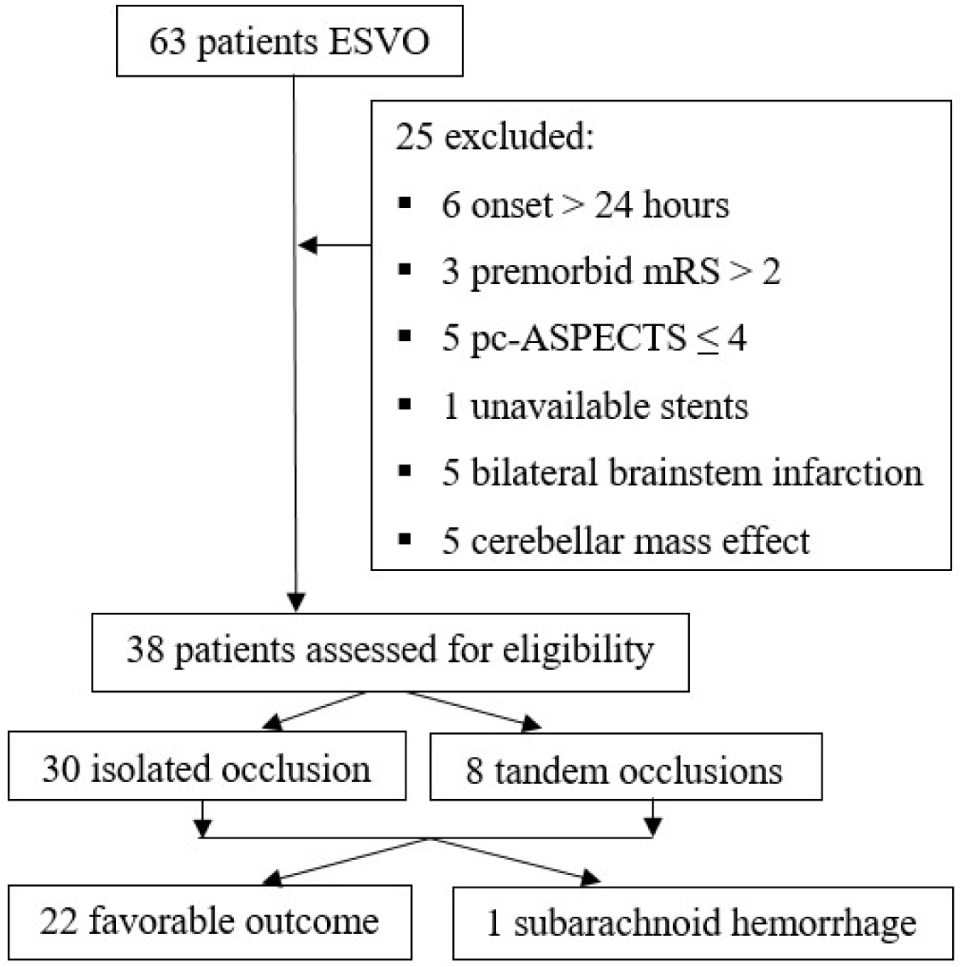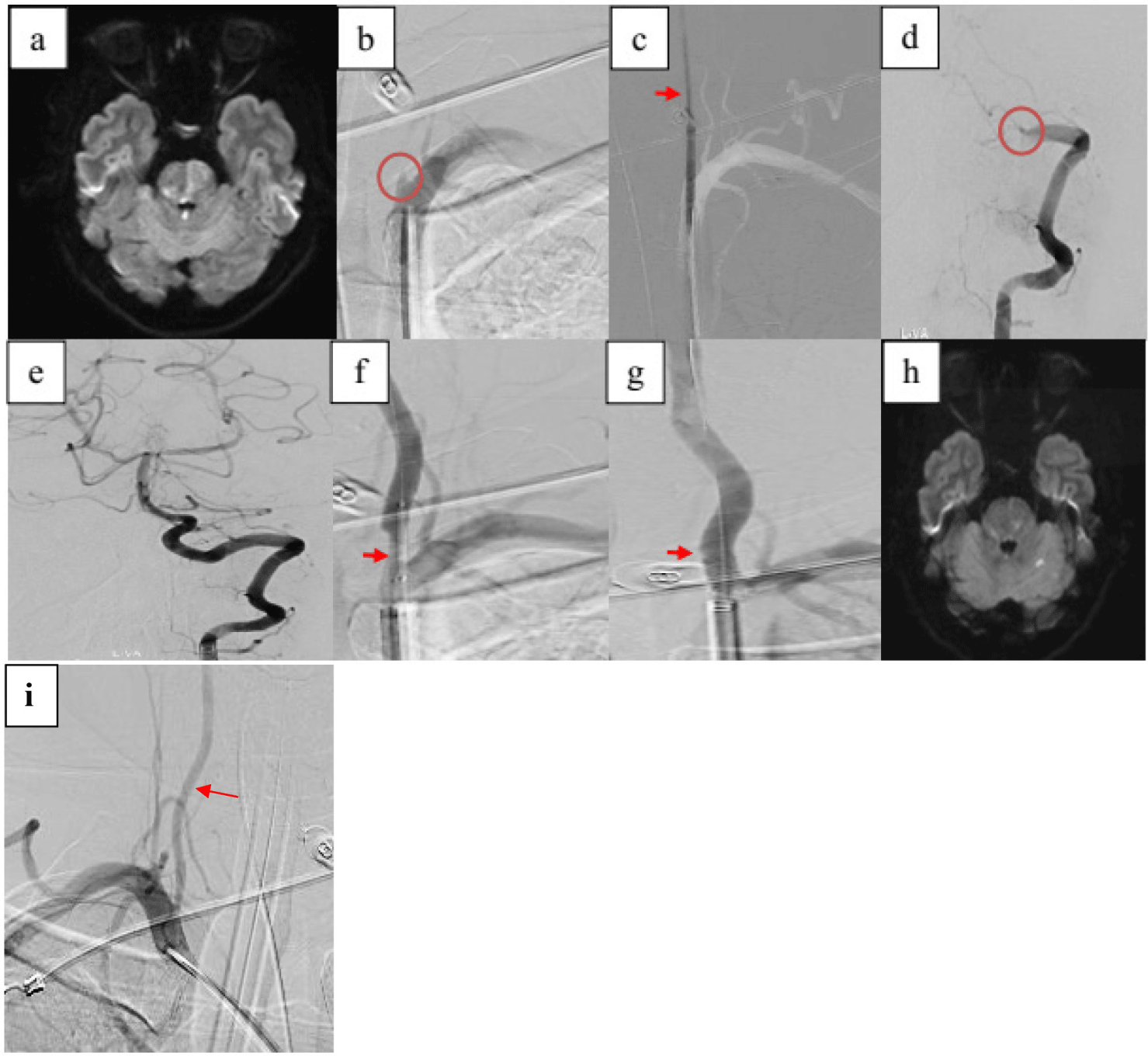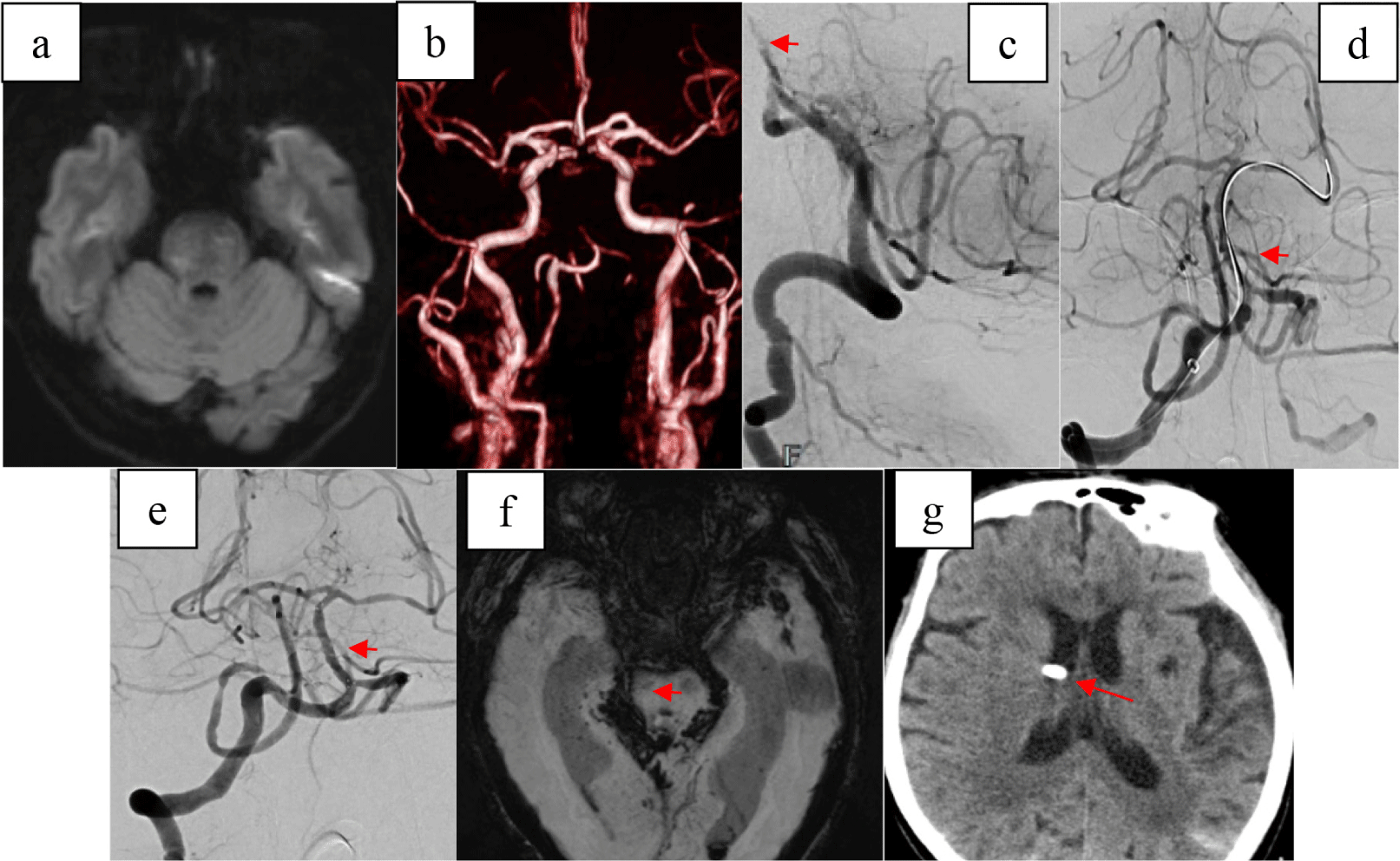1. INTRODUCTION
Posterior acute ischemic strokes account for approximately 20%–25% of all ischemic strokes, with large vessel occlusions (LVOs) occurring in 0.8%–5.7% of cases [1,2]. Mechanical thrombectomy (MT) has been the standard treatment for LVOs; however, the rate of futile recanalization - defined as an unsatisfactory outcome despite successful early recanalization - is higher in posterior circulation strokes compared to anterior ones [3]. This demonstrates an ongoing challenge in achieving optimal clinical outcomes. Randomized controlled trials, including BEST, BASICS, BAOCHE, and ATTENTION, have demonstrated the potential benefits of endovascular treatment over standard medical therapy for acute vertebrobasilar occlusions [4–7]. Nevertheless, the BASICS trial specifically did not establish the superiority of thrombectomy over medical treatment alone. Furthermore, these trials reported symptomatic intracranial hemorrhage and mortality rates for endovascular treatment of approximately 6% [6] and 37%, respectively [7]. These findings underscore the need for additional refinement of therapeutic techniques in this context.
Complicating the management of acute vertebrobasilar strokes are underlying intracranial stenosis, which is observed up to 36% of LVO cases [8], and tandem lesions, which occur in 64% [9]. Emergent stenting has been recommended as a rescue strategy in cases of failed mechanical thrombectomy, facilitating successful recanalization [10]. Given that effective recanalization is a key predictor of positive outcomes [11], knowing the impact of emergent stenting is essential. However, the necessity for dual antiplatelet therapy (DAPT) and the associated risk of complications continue to raise concerns about its overall efficacy [12,13].
Recent studies have explored several elements of rescue stenting in vertebrobasilar strokes, including the outcomes of stenting following failed thrombectomy [14]. Furthermore, Grunwald et al. [15] and Nardai et al. [16] have examined rescue stenting in cases of basilar thrombectomy failure and coronary stent implantation for acute basilar artery (BA) occlusion, respectively. Despite these advances, considerable knowledge gaps exist about long-term clinical outcomes and optimal patient selection for emergency stenting.
Hence, we sought to evaluate the safety and efficacy of acute stenting in acute ischemic stroke caused by vertebrobasilar occlusion.
2. MATERIAL AND METHODS
We retrospectively evaluated all patients with acute vertebrobasilar occlusions stroke, who received emergent stenting at Can Tho S.I.S. General Hospital between December 2020 and November 2023. Vertebrobasilar occlusions were classified as tandem occlusions (defined as severe stenosis or occlusion of the vertebral artery (VA) ostium concurrent with the BA occlusion) and isolated occlusion (either intracranial segment of VA or basilar arteries). These lesions were confirmed by digital subtraction angiography (DSA). Patients were included if they are (1) age>18 years old; (2) the admission severity of stroke using the National Institutes of Health Stroke Scale (NIHSS)≥5 or Glasgow Outcome Score≥9; (3) onset to treatment time<24 hours; (4) posterior circulation Acute Stroke Prognosis Early Computed Tomography Score (pc-ASPECTS) greater or equal to 5 on Magnetic resonance imaging (MRI) 3 Tesla. The exclusive criteria included: (1) pre-stroke modified Rankin Scale (mRS)>2; (2) Large bilateral brain-stem infarcts including as the midbrain and the pons based on pc-ASPECTS; (3) effect of cerebellar mass (Fig. 1). Our study has followed the STROBE guidelines [17] and checklist in Supplementary Table S1.

Emergent stenting was done under general anesthesia using a transfemoral approach. The 8F guiding catheter accessed to the dominant VA, if other VA was hypoplasia or tortuous vessel anatomy by DSA guidance. In single or tandem occlusions, our study used a “distal-to-proximal” method (defined as effective recanalization after the occlusive lesion performed initially by MT, followed by emergent stenting for the severe stenosis or re-occlusion following MT or angioplasty) in our study. There were many ways to allow the 8F guiding catheter to cross VA ostium occlusion in tandem lesions: (1) support of the 5F diagnostic catheter; (2) support of the dilator available of 8F guiding catheter; (3) temporary angioplasty. Following successful recanalization in the intracranial regions, balloon-expandable stent was fully placed in extracranial lesion. In isolated lesions had two occlusive characteristics: tapered or blunt stump. If there was a tapered stump in the angiography, primary direct angioplasty was performed without prior mechanical thrombectomy. In the event of blunt stump, MT was performed first to disclose the tapering stump, followed by angioplasty. Angiographic results of 2 cases showed the severe stenosis or re-occlusion after angioplasty, emergent stent (balloon-expandable or self-expanding stent such as Wingspan - Stryker Neurovascular, Fremont, CA, USA; Credo - Acandis, Pforzheim, Germany, and LEO stent - Balt Extrusion, Montmorency, France) was deployed in the target artery. The loading doses of DAPT regimens were determined by institutional protocol and began prior to the procedure with both 300 mg clopidogrel and 162 mg acetylsalicylic acid administred by nasogastric tube. In addition, an intravenous bolus dosage of 3,000–5,000 IU heparin was administered throughout the surgery. When subarachnoid hemorrhage or malignant cerebellar edema was visible in the post-procedure imaging (CT or MRI), the discontinuation of DAPT and neurosurgical procedures were considered. The degree of recanalization was assessed by the modified treatment in cerebral infarction (mTICI), especially successful cases with mTICI≥2b. Procedural time was defined as the time between groin puncture to final recanalization. At 3 months, the change of degree of clinical result was assessed by mRS which constituted of favorable outcomes mRS less than or equal to 3 and unfavorable outcomes (mRS≥4). The 3-month score was assessed through follow-up examination by either the direct examination or phone interviews. Our anlaysis included two examples of tandem occlusions and one occlusion from our study (Figs. 2 and 3).


All statistical tests were performed using Stata statistical software, version 16 (StataCorp College Station, TX, USA). Statistical significance for intergroup differences was assessed with Fisher exact test for categorical variables. All tests were two sided with levels of p<0.05 considered to be statistically significant. Fisher’s exact test was used to explore intergroup differences between patients with tandem occlusions and those with isolated occlusions in vertebrobasilar strokes. Specifically, we compared clinical outcomes (favorable outcome defined as mRS≤3 and unfavorable outcomes mRS≥4 at 3 months) and complication rates, including symptomatic intracranial hemorrhage, between these two groups.
Our study is registered in the ClinicalTrials.gov with ID NCT06129721. The study relating to human participants was recorded and approved by the Ethics Council in biomedical research in Can Tho S.I.S General Hospital (number 11623/QD-S.I.S on May 19th, 2023) and Ethical Board of the University of Medicine and Pharmacy at Ho Chi Minh City (number 1087/HDDD-DHYD on November 2nd, 2023). Informed consent was accepted from the patient representatives.
3. RESULTS
From December 2020 to November 2023, 38 eligible patients received ES at our hospital. Patients’ age ranged from 44 to 93 years old, and a mean age (SD) of 65.5 (10.8) years old. 36.8% were over the age of 70, with men accounting for 78.9%. The moderate admission NIHSS (5≤NIHSS≤15) accounted for 36.8% and baseline pc-ASPECTS was 6.7 (SD 1.1) (Table 1). Neurovascular risk factors for acute ischemic stroke comprised of smoking (71.1%), hyperlipidemia (18.4%), and diabetes mellitus (36.8%), but no significant difference between these factors was found in good outcome at 3 months (Table 2). In the included patients, 8 (21.1%) had a tandem occlusion and 30 (78.9%) with the underlying intracranial stenosis at the level of the occlusion of the target artery, which included 11 (28.9%) VA and 19 (63.3%) BA. Tandem occlusion did not indicate an additional underlying intracranial stenosis. In tandem lesions, the dilator supported the 8F guiding catheter less than the 5F diagnostic catheter (7.9% and 13.2%; respectively). Mechanical thrombectomy was commonly applied to treat occlusive lesion underlying intracranial stenosis (55.3%). Furthermore, one Embolic Protection Device (SpiderFXTM - Medtronic, Minneapolis, MN, USA) was employed to prevent plaque debries after thrombectomy at intracranial occlusion in tandem lesions. 37 open-cell stents were employed, including 24 self-expanding and 6 balloon-expandable stents in the isolated lesion. In case of intracranial 1 close-cell stent (LEO stent) was deployed in intracranial VA stenosis. Additionally, the symptomatic hemorrhagic complication rate recorded one case (2.6%) subarachnoid hemorrhage. The baseline pc-ASPECTS was was 6.7 (SD 1.1) accounted for 36.8% of the hospital stays shorter than 14 days, which was statistically different between tandem and isolated lesions(p=0.004), shown in Table 3.
Although there was a shift toward lower degree of disability from 9 in discharge to 19 good outcomes at 3-month (Fig. 4), this difference was not significant between tandem and isolated occlusion (p=0.7). The overall study mortality was 21.1% (including one patient in tandem occlusions and 7 patients with isolated occlusions).

4. DISCUSSION
With death rate of 85% in the absence of effective recanalization, acute vertebrobasilar occlusion is a potentially fatal disease [18]. Our study demonstrated that the efficacy of endovascular therapy, especially when used in conjunction with the retrograde method, is effective in improving clinical outcomes. The 3-month good outcome rates were 62.5% for tandem lesions and 56.7% for isolated lesions, surpassing previously reported single-center data (52.4% for tandem and 51.9% for isolated lesions) [19,20]. This suggests that emergent stenting increases the likelihood of successful rehabilitation in addition to improving survival, which is consistent with data showing that timely initiation of physical, occupational, and cognitive rehabilitation is essential for optimizing functional outcomes in stroke survivors [21]. Mortality rates also differed between lesion types, with isolated lesions having a higher rate (18.4%) compared to tandem lesions (2.6%). We were able to locate them in the the target arteries in posterior circulation right away because of the MRI3 Tesla’s sensitive acute ischemia detection. Nevertheless, the identification of the tandem and single intracranial occlusion was solely based on the DSA. Besides, DSA allowed to determine exactly the occluded dominant VA to place 8F guiding catheter, which made endovascular therapy do recanalization easily. Endovascular therapy for vertebrobasilar occlusions demonstrated similar good outcomes for tandem and isolated lesions compared to earlier studies [22–24]. Detection of ischemia using 3T MRI was pivotal, complementing DSA’s capacity to identify occlusions and guide catheter placement for efficient recanalization. Although our findings on the mortality and outcomes of isolated versus tandem lesions are consistent with previously reported data, they highlight the benefits of targeting tandem lesions due to its procedural efficiency. Hemorrhagic complications were rare but important. One case of iatrogenic subarachnoid hemorrhage occurred due to excessive microcatheter and microwire passes, underscoring procedural risks associated with posterior cerebral artery access. This aligns with Lee et al.’s findings on the risks of distal vessel access and multiple device passes [25].
Although there were 3 cases with isolated lesion received intravenous rTPA as the bridging agent, all of them had poor outcomes following ES, and the difference was not significant between groups (p=0.5).
In the early stages of stroke, a impaired consciousness is a typical symptom in acute vertebrobasilar occlusion and is involved in injury of the lower dorsal ascending reticular activating system [20]. It was the cause of the stupor was the most common admitted consciousness (55.3%) in the acute vertebrobasilar occlusion in our study.
In tandem lesions, the thrombi was the main reason caused by the single intracranial occlusion without underlying intracranial stenosis. This was an advantageous factor in saving procedural time. However, in the single intracranial occlusion, the mechanical thrombectomy, which was mostly the first approach to expose the severe stenosis clearly (55.3%), to increase both procedural time and high risk. The number of patients with procedural time≥60 mins was less than ones with isolated lesions (13.2% and 57.9%; respectively), and the two groups were not significantly different (p=0.7).
In addition to treatment, the length of hospital and ICU stays, was a barrier to improve the post-procedure outcome. Hospital-acquired pneumonia, which was the most common infection in the ICU, increased duration of using the antibiotics and high-risk antibiotic resistance [25]. In our study, the length of stay in ICU≥6 days and that of hospital stay≥14 days were significantly associated to adverse outcomes (p=0.03). In this descriptive study, we aimed to propose a novel approach following the failure of mechanical thrombectomy in posterior stroke, a rare and understudied condition. Due to the small sample size and the absence of comparable groups, controlling for selection bias and confounding factors was not feasible. While 3T MRI proved effective, diffusion-weighted imaging on 1.5T MRI may be non-inferior for patient selection, warranting further exploration. Although ideal, multivariate analysis was not suited for the study’s descriptive nature and small sample size. We acknowledge these limitations and propose larger, prospective studies to validate our observations and strengthen the evidence base. The small sample sizes in both groups significantly reduced the statistical power of Fisher’s exact test, increasing the likelihood of Type II errors where real differences may exist but were not detected. In the context of small sample sizes, p-values may not accurately reflect the observed data, leading to seemingly counterintuitive results. The limitations of using p-values alone for interpretation are highlighted by this instability in significance testing. Given these limitations, the small sample size should be acknowledged as a significant constraint of this study. The unusually high p-values for some variables may not truly reflect the underlying associations, emphasizing the need for cautious interpretation and further investigation with larger cohorts.
5. CONCLUSION
While our study suggests that emergent stenting may improve outcomes and have a low risk of complications in cases of failed mechanical thrombectomy for posterior strokes, these observations should be interpreted with caution due to the absence of a control group. The descriptive findings provide a foundation for further investigation, but definitive conclusions about efficacy and safety require validation through controlled studies. Nonetheless, this study underscores the potential of emergent stenting as a promising intervention in the posterior LVO.








